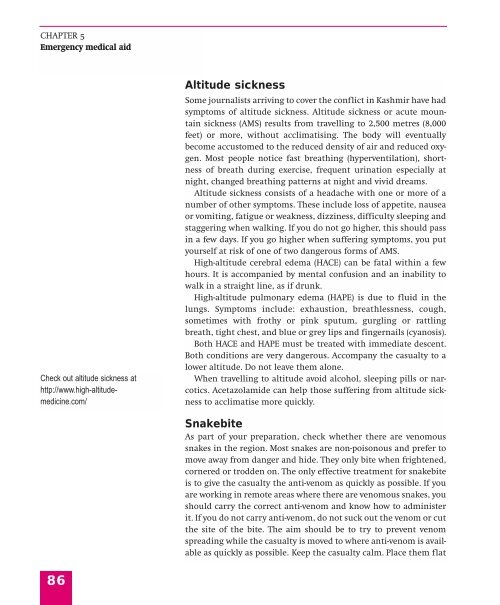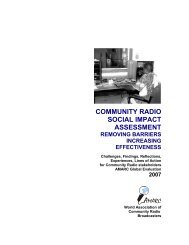Live News - A Survival Guide - International Federation of Journalists
Live News - A Survival Guide - International Federation of Journalists
Live News - A Survival Guide - International Federation of Journalists
- No tags were found...
Create successful ePaper yourself
Turn your PDF publications into a flip-book with our unique Google optimized e-Paper software.
CHAPTER 5Emergency medical aidCheck out altitude sickness athttp://www.high-altitudemedicine.com/Altitude sicknessSome journalists arriving to cover the conflict in Kashmir have hadsymptoms <strong>of</strong> altitude sickness. Altitude sickness or acute mountainsickness (AMS) results from travelling to 2,500 metres (8,000feet) or more, without acclimatising. The body will eventuallybecome accustomed to the reduced density <strong>of</strong> air and reduced oxygen.Most people notice fast breathing (hyperventilation), shortness<strong>of</strong> breath during exercise, frequent urination especially atnight, changed breathing patterns at night and vivid dreams.Altitude sickness consists <strong>of</strong> a headache with one or more <strong>of</strong> anumber <strong>of</strong> other symptoms. These include loss <strong>of</strong> appetite, nauseaor vomiting, fatigue or weakness, dizziness, difficulty sleeping andstaggering when walking. If you do not go higher, this should passin a few days. If you go higher when suffering symptoms, you putyourself at risk <strong>of</strong> one <strong>of</strong> two dangerous forms <strong>of</strong> AMS.High-altitude cerebral edema (HACE) can be fatal within a fewhours. It is accompanied by mental confusion and an inability towalk in a straight line, as if drunk.High-altitude pulmonary edema (HAPE) is due to fluid in thelungs. Symptoms include: exhaustion, breathlessness, cough,sometimes with frothy or pink sputum, gurgling or rattlingbreath, tight chest, and blue or grey lips and fingernails (cyanosis).Both HACE and HAPE must be treated with immediate descent.Both conditions are very dangerous. Accompany the casualty to alower altitude. Do not leave them alone.When travelling to altitude avoid alcohol, sleeping pills or narcotics.Acetazolamide can help those suffering from altitude sicknessto acclimatise more quickly.SnakebiteAs part <strong>of</strong> your preparation, check whether there are venomoussnakes in the region. Most snakes are non-poisonous and prefer tomove away from danger and hide. They only bite when frightened,cornered or trodden on. The only effective treatment for snakebiteis to give the casualty the anti-venom as quickly as possible. If youare working in remote areas where there are venomous snakes, youshould carry the correct anti-venom and know how to administerit. If you do not carry anti-venom, do not suck out the venom or cutthe site <strong>of</strong> the bite. The aim should be to try to prevent venomspreading while the casualty is moved to where anti-venom is availableas quickly as possible. Keep the casualty calm. Place them flat86
















